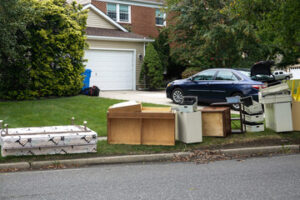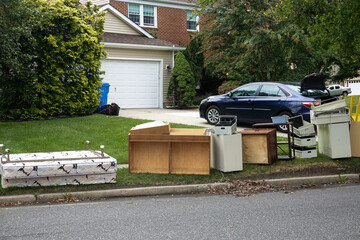Decluttering can feel like an overwhelming task, especially when faced with years of accumulated possessions. However, by understanding the essentials of junk removal, the process can become manageable and even rewarding.
The key to successful decluttering is to approach it systematically, making clear decisions about what to keep, donate, recycle, or discard. Recognizing the emotional and practical barriers to decluttering is the first step in making the task easier and more effective. Contact Scottsdale Junk Removal for professional help.
Many people hold onto items due to sentimental attachment, fear of waste, or uncertainty about their future utility. These psychological barriers can create hesitation, leading to clutter accumulation over time. A practical approach involves setting clear goals, categorizing belongings, and creating a decluttering schedule that suits one’s lifestyle. By breaking down the process into smaller, more achievable tasks, individuals can prevent feeling overwhelmed and maintain motivation throughout the process.
One of the most effective strategies for decluttering is the room-by-room method. Instead of attempting to tackle an entire home at once, focusing on one area at a time allows for more manageable progress. This method ensures that each space is properly assessed, and decisions about items can be made without rushing. The process often begins with common clutter zones such as closets, garages, and storage rooms. These areas tend to accumulate unnecessary items, and clearing them out first creates a sense of accomplishment that encourages further decluttering efforts.
An important part of junk removal is distinguishing between what is necessary and what is simply taking up space. Items that have not been used in a year or more, duplicates of the same product, or things that no longer serve a practical purpose should be considered for removal. While certain possessions may carry sentimental value, it is crucial to evaluate whether they contribute positively to one’s daily life or if they simply add to the clutter. Photographs, letters, and meaningful keepsakes can be preserved in organized storage systems rather than scattered throughout the home.
A major challenge in decluttering is deciding what to do with unwanted items. The best approach involves sorting these belongings into different categories: those that can be donated, those that can be recycled, and those that need to be discarded. Donation is a great way to give a second life to items that are still functional but no longer needed. Many people find satisfaction in knowing that their belongings will be used by someone in need rather than ending up in a landfill. Recycling is another responsible option for items such as electronics, paper, and plastics, which can be repurposed rather than wasted. When disposal is necessary, proper waste management practices should be followed to minimize environmental impact.
One effective method of decluttering is adopting a minimalist mindset. This does not necessarily mean getting rid of everything, but rather prioritizing quality over quantity. A minimalist approach encourages individuals to keep only the things that add value and bring joy to their lives. By practicing mindful consumption, one can prevent clutter from accumulating in the future. Before acquiring new items, it is helpful to consider whether they are truly needed or if they will contribute to excess accumulation over time.
Another helpful strategy is setting realistic decluttering goals. Some individuals find it beneficial to dedicate a set amount of time each day or week to the task. This approach prevents the process from becoming too exhausting and allows for steady progress. Decluttering does not have to be completed in one day; taking it step by step ensures that the task remains manageable and sustainable. Establishing a habit of regular decluttering can also prevent the need for major cleanouts in the future.
Storage solutions play a crucial role in maintaining a clutter-free environment. Proper organization ensures that essential items remain accessible while minimizing visual chaos. Using storage containers, shelving units, and labeling systems helps create an orderly space where everything has its designated place. Investing in practical storage solutions can prevent clutter from accumulating again, making it easier to maintain a clean and organized home.
One common mistake in decluttering is holding onto items due to guilt. Many people keep things they do not use simply because they were gifts or because they spent money on them. However, it is important to recognize that keeping such items out of guilt only contributes to clutter. Instead, acknowledging their past purpose and letting them go can create space for more meaningful and useful possessions. Letting go of items that no longer serve a purpose is an act of self-care that allows individuals to create an environment that truly supports their well-being.
A major benefit of decluttering is the positive impact it has on mental and emotional well-being. A clutter-free space promotes a sense of calm and order, reducing stress and increasing productivity. Many people find that a clean and organized environment enhances their ability to focus and think clearly. Decluttering can also create a sense of accomplishment, boosting overall motivation and encouraging other positive habits. By removing excess possessions, individuals often feel a renewed sense of control over their surroundings and their lives.
The process of junk removal can be simplified by using a systematic approach. One helpful technique is the “one in, one out” rule, which ensures that for every new item brought into the home, an old item is removed. This method prevents accumulation and maintains a balanced environment. Another strategy is to keep a designated donation box in the home, where items that are no longer needed can be placed. When the box is full, it can be donated, making the decluttering process continuous and effortless.
Technology can also assist in the decluttering process. Digital storage solutions can help reduce the need for physical copies of documents, photographs, and notes. By scanning and storing important files electronically, individuals can free up space while still retaining access to essential information. Digital decluttering is just as important as physical decluttering, as excessive digital clutter can also lead to stress and disorganization.
One of the best ways to make decluttering easier is to involve others in the process. Family members, friends, or professional organizers can provide valuable support and motivation. Having someone else present can also help in making objective decisions about what to keep and what to remove. Additionally, decluttering as a group can make the process more enjoyable and efficient. When working with others, it is helpful to set shared goals and celebrate progress along the way.
Another crucial aspect of decluttering is developing a long-term maintenance plan. Without ongoing effort, clutter can quickly return, undoing all previous work. Creating daily or weekly habits that prevent accumulation is essential in maintaining a clutter-free environment. Simple habits such as immediately putting things back in their place, avoiding impulse purchases, and regularly reassessing belongings can make a significant difference. A well-maintained space is not only more visually appealing but also contributes to overall peace of mind.
Decluttering is more than just removing junk; it is a transformative process that leads to a more organized, efficient, and stress-free living space. By following a structured approach, making mindful decisions, and implementing effective strategies, anyone can achieve a clutter-free environment. The benefits of decluttering extend beyond the physical space, improving mental well-being and overall quality of life. Through careful planning, persistence, and a commitment to ongoing organization, individuals can create a home that truly reflects their needs and aspirations.

